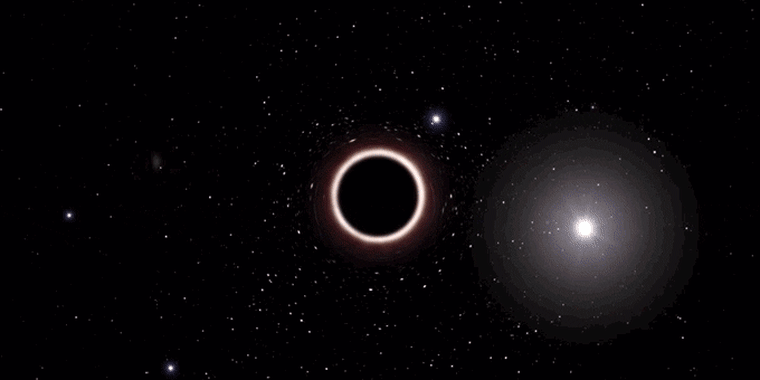Black holes are the dark remnants of collapsed stars, regions of space cut off from the rest of the universe. If something falls into a black hole, it can never come back out. Not even light can escape, meaning black holes are invisible even with powerful telescopes. Yet physicists know black holes exist because they’re consistent with time-tested theories, and because astronomers have observed how matter behaves just outside a black hole.
Naturally, science fiction loves such an enigmatic entity. Black holes have played starring roles in popular books, movies and television shows, from "Star Trek" and "Doctor Who" to the 2014 blockbuster "Interstellar."
But black holes aren’t quite as menacing as they are commonly portrayed. “They definitely do not suck,” says Daryl Haggard, an astrophysicist at McGill University in Montreal. “A black hole just sits there, passively. Things can fall onto it, just as meteors can fall to Earth, but it doesn’t pull stuff in.”
How do black holes form?
The force of gravity governs the motion of planets, stars and galaxies, and it’s responsible for creating black holes, too.
Stars shine because of the nuclear fusion reactions taking place in their cores. The reactions create an outward pressure that counters the inward pull of gravity. As a result, the star neither expands nor contracts. But when a star’s fuel supply is exhausted and the outward pressure stops, gravity causes the star to shrink.
What happens next depends on the size of the star. If it’s about the mass of our sun or a bit bigger, it will collapse until it’s a roughly Earth-size body known as a white dwarf. Stars that are significantly larger will collapse into an ultra-dense object known as a neutron star. If it’s really big, the collapse cannot be stopped — and you get a black hole.
Why can’t anything escape from a black hole? The key is something called escape velocity: the speed needed to overcome the gravitational tug of a particular star or planet and move out into space.
Earth’s escape velocity is about seven miles per second, or about 25,000 miles an hour. Throw a baseball into the air and it falls back down because its speed is lower than Earth’s escape velocity; if your fastball exceeded 25,000 miles an hour, it would never come down.
Escape velocity is highest for objects that are massive but small in size. In the case of a black hole, the escape velocity is greater than the speed of light. Since nothing can travel faster than light (something Einstein showed with his theory of relativity), the star disappears. With light unable to escape, it appears black.
A black hole is bounded by its event horizon, the imaginary sphere that represents the region where the escape velocity is exactly equal to the speed of light.
Black holes vary in size, with masses ranging from a handful of suns (and a diameter of a few miles) up to millions of solar masses (and a diameter of several million miles). The largest of these so-called supermassive black holes are believed to lie at the center of most galaxies, including our own Milky Way.
Astronomers are still debating how these colossal black holes form. One possibility is that they’re the result of mergers between star-size black holes.
What’s inside a black hole?
No one knows exactly what lies within a black hole’s event horizon. Some physicists hypothesize that matter inside is so compressed that it forms a point of infinite density known as a singularity. In this view, a black hole can be thought of as empty space, with its mass concentrated at an infinitesimal point in the center.
Anyone unlucky enough to fall into a black hole would be torn apart by the intense gravity — stretched like spaghetti, as Stephen Hawking famously put it — with his or her mass added to the black hole’s.
Other physicists question this view of the interior of a black hole, arguing that a more comprehensive physical theory — one that combines Einstein’s theory of gravity with quantum theory — might do away with singularities.
Black holes may be dark, but that doesn’t mean we can’t study them
Astronomers have learned a great deal about black holes by watching what happens to gas and dust that fall into them. Such material can reach very high temperatures, causing it to emit light at various wavelengths.
The Event Horizon Telescope, a globe-spanning array of radio telescopes, is giving astronomers their closest look yet at the region immediately outside a black hole. Astronomers have also used the Very Large Telescope in Chile to study the motion of stars near the Milky Way’s supermassive black hole, known as Sagittarius A* (pronounced “Sagittarius A-star”). From these motions it’s possible to infer some of the properties of the black hole.
The 2015 discovery of gravitational waves means that scientists can use these waves to study collisions between black holes in deep space.
WANT MORE STORIES ABOUT SPACE?
- Astronauts could stay at this space 'motel' on the way to Mars
- Tiny satellites are reshaping spaceflight in a big way — and bringing new risks
- Astronaut inspired by 'The Right Stuff' gets set for the second act he never expected

